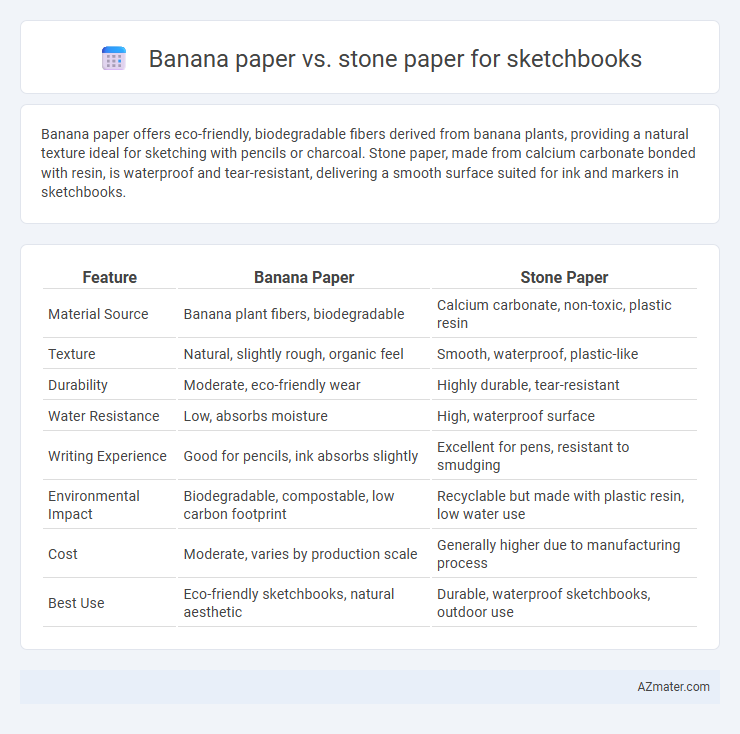Banana paper offers eco-friendly, biodegradable fibers derived from banana plants, providing a natural texture ideal for sketching with pencils or charcoal. Stone paper, made from calcium carbonate bonded with resin, is waterproof and tear-resistant, delivering a smooth surface suited for ink and markers in sketchbooks.
Table of Comparison
| Feature | Banana Paper | Stone Paper |
|---|---|---|
| Material Source | Banana plant fibers, biodegradable | Calcium carbonate, non-toxic, plastic resin |
| Texture | Natural, slightly rough, organic feel | Smooth, waterproof, plastic-like |
| Durability | Moderate, eco-friendly wear | Highly durable, tear-resistant |
| Water Resistance | Low, absorbs moisture | High, waterproof surface |
| Writing Experience | Good for pencils, ink absorbs slightly | Excellent for pens, resistant to smudging |
| Environmental Impact | Biodegradable, compostable, low carbon footprint | Recyclable but made with plastic resin, low water use |
| Cost | Moderate, varies by production scale | Generally higher due to manufacturing process |
| Best Use | Eco-friendly sketchbooks, natural aesthetic | Durable, waterproof sketchbooks, outdoor use |
Introduction to Sustainable Paper Alternatives
Banana paper and stone paper represent innovative sustainable alternatives to traditional wood-pulp sketchbook materials, providing eco-friendly options for artists. Banana paper is crafted from banana plant fibers, offering biodegradable and biodegradable properties with minimal water usage and chemical processing. Stone paper, made from calcium carbonate and resin, is water-resistant, tear-resistant, and chlorine-free, creating a durable, tree-free medium that reduces environmental impact.
What is Banana Paper?
Banana paper is an eco-friendly alternative made from the fibers of banana plant stalks, offering durability and a smooth texture ideal for sketchbooks. It is biodegradable, sustainable, and requires fewer chemicals and water in production compared to traditional paper. This natural material provides a unique surface that absorbs ink and pencil with minimal smudging, making it popular among artists seeking environmentally conscious sketchbook options.
What is Stone Paper?
Stone paper is a sustainable, tree-free material made from calcium carbonate bonded with non-toxic resin, offering a smooth, waterproof, and tear-resistant surface ideal for sketchbooks. Unlike traditional paper, stone paper is highly durable and environmentally friendly, reducing deforestation and water consumption during production. Its unique texture provides artists with a versatile medium that supports various drawing tools without bleeding or smudging.
Environmental Impact Comparison
Banana paper for sketchbooks is made from banana plant fibers, which are a renewable resource and use agricultural waste, significantly reducing deforestation and water consumption compared to traditional paper. Stone paper, derived from calcium carbonate and resin, requires no water and uses less energy but depends on non-renewable minerals and can produce microplastic pollution during degradation. Both alternatives offer eco-friendly benefits over conventional wood-pulp paper, but banana paper's biodegradability and lower fossil fuel reliance give it a stronger overall environmental advantage.
Texture and Surface Quality
Banana paper offers a naturally fibrous texture that provides a warm, tactile surface ideal for sketching with pencils and charcoal, enhancing grip and artistic control. Stone paper features a smooth, waterproof surface with minimal grain, ensuring consistent ink absorption and resistance to smudging, which benefits fine liners and markers. Both materials deliver unique surface qualities: banana paper emphasizes organic texture for expressive strokes while stone paper prioritizes durability and clean, crisp finishing.
Durability and Longevity
Banana paper, made from banana plant fibers, offers moderate durability and is biodegradable, making it an eco-friendly choice for sketchbooks with reasonable longevity under normal use. Stone paper, composed of calcium carbonate and resin, is highly durable, water-resistant, and tear-proof, providing exceptional longevity and resilience against environmental wear and tear. For artists seeking long-lasting, robust sketchbooks, stone paper delivers superior performance, while banana paper suits sustainable, lightweight projects with moderate lifespan requirements.
Ink and Media Compatibility
Banana paper offers excellent ink absorption and works well with fountain pens, markers, and watercolors, minimizing bleed-through and feathering for detailed sketching. Stone paper provides a smooth, waterproof surface ideal for pencil, pen, and marker use but may struggle with heavy watercolor or ink washes due to its non-porous texture. Artists seeking durable, ink-friendly sketchbook pages should weigh banana paper's natural fibers against stone paper's synthetic, smear-resistant qualities for optimal media compatibility.
Cost and Availability
Banana paper generally costs more than stone paper due to its eco-friendly production process using banana fibers, which are less common and require specialized manufacturing. Stone paper, made from calcium carbonate and resin, is often more affordable and widely available because of its synthetic material base and scalable production. Availability varies regionally; stone paper is more common in urban markets, while banana paper is typically found in niche or artisanal supply stores focusing on sustainability.
Artist Experiences and Reviews
Artists praise banana paper for its eco-friendly texture and durability, offering a unique tactile experience that enhances pencil and ink sketches while maintaining vibrant color retention. Stone paper, favored for its smooth surface and water-resistant properties, provides a mess-free platform ideal for marker and watercolor work, though some users note it may lack the natural feel preferred in traditional sketching. Reviews highlight banana paper's biodegradability versus stone paper's longer-lasting, tear-resistant qualities, influencing artists' choices based on their medium and sustainability priorities.
Conclusion: Which is Better for Sketchbooks?
Banana paper offers exceptional eco-friendliness and a unique texture that enhances pencil and charcoal sketches, while stone paper is waterproof, tear-resistant, and ideal for ink or marker use. For artists prioritizing sustainability and organic materials, banana paper is the preferred choice, whereas stone paper suits those needing durability and smudge-proof pages. Ultimately, selecting between banana paper and stone paper depends on the medium and environmental values of the sketchbook user.

Infographic: Banana paper vs Stone paper for Sketchbook
 azmater.com
azmater.com